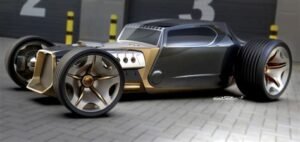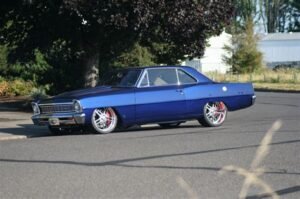
Classically, classic cars are about great style and a driving experience, while their original suspension systems are usually pretty weak in comfort and handling. One of the best ways to improve this a lot is to install an air-ride suspension system on your classic car; this will make a huge difference in ride quality, ride height adjustment, and overall driving experience. This article discusses some aspects of air-ride suspension for classic cars, its benefits, types, installation process, and maintenance.
Advantages of Air Ride Suspension
Air ride suspension offers advantages over more conventional coil spring or leaf spring systems, especially when it comes to classic cars. These are:
Improved Ride Quality
Air ride systems are far superior in terms of soaking up bumps and irregularities in the road surface, making for a much smoother and more comfortable ride. The air springs could be adjusted to compensate for different load conditions, ensuring the optimal ride quality whether you’re driving solo or with passengers and luggage aboard. In particular, this is great for classic cars because most have far stiffer suspensions that were designed for handling rather than comfort.
Adjustable Ride Height
One of the most attractive aspects of the air ride suspension has to be the adjustability of ride height. It is good to go, lowering the car for that wholesome, sporty look along with enhanced handling or raising it for better ground clearance to ensure safe passage across obstacles. This makes such a system highly beneficial for classic car owners who may need to drive their vintage cars on uneven terrain or through tight parking spaces.
Improved Handling
Air ride suspension systems can even improve the handling qualities of your classic car, thanks to more precise control over the movements of the vehicle. That ability to adjust the suspension stiffness and ride height allows fine-tuning the car’s handling at will, providing responsive and enjoyable driving.
Increased Safety
Air ride suspension can add a degree of safety to the classic car by improving stability and reducing the possibilities of bottoming out on rough roads. Adjustable ride height allows you to raise the car to clear obstacles; meanwhile, the smooth ride from the air springs is very important to staying in control during difficult driving situations.
Types of Air Ride Suspension Systems
These Air Ride suspension systems are available in different configurations, each with a varying degree of adjustability and features. Following are some of the common types: –
Bag-over-Coil Systems
Its popularity is based on simplicity, which makes them attractive options to upgrade amongst classic car owners. These systems replace factory coil springs with air springs that fit over the coil spring perch. The air springs would then be connected to an air management system that allows adjusting ride height and suspension stiffness.
Pros:
- The easy installation only requires minor modification to the existing suspension.
- Less expensive than other air-ride systems.
Cons:
- Less adjustability than with some other systems.
- Do not provide the same performance levels as dedicated air-ride systems.
Dedicated Air Ride Systems
A dedicated air ride system is an altogether more comprehensive upgrade; it replaces the entire suspension setup with specialized components for air ride applications. The major components this system is usually made up of include air springs, adjustable shocks, and a dedicated air management system regulating everything from ride height to suspension stiffness and beyond.
Pros:
- Most adjustability, ultimate control in the suspension characteristics.
- Better performance and handling than bag-over-coil systems.
Cons:
- More complicated installation; lots of modifications in the suspensions.
- More expensive as compared to bag-over-coil systems.
Air Ride Suspension Kits
Pre-packaged air ride suspension kits make the installation of an air ride relatively easy for the owner of a classic car. All parts to accomplish this installation, like air springs, shocks, air lines, control valves, and an air management system, will be in one convenient package and vehicle-specific. While installation using a kit will be easier, you must get a kit designed for your car to be sure it is compatible with your vehicle and will function optimally.
Pros:
- Convenience of having it all in one package for easier installation.
- Kits can come with particular parts to allow for compatibility with suspension on the vehicle.
Cons:
- Not as customizable as buying individual components.
- Kits tend to be a bit more expensive than purchasing individual components.
Installing Air Ride Suspension
Installing an air ride suspension system onto a classic car can be a rather involved process that may require a great deal of care and attention. Here is a general overview of installing an air ride suspension system onto a classic car:
Preparation
These are the things to be prepared prior to installation: a jack, stands, wrenches, sockets, an air compressor, and specialty tools for specific components, as may be required.
Original Suspension Removal
This will include removing the original suspension components such as coil springs, shocks, and associated hardware. Make sure you have a safe and stable workspace, taking note of the order of removal to facilitate reassembly.
Installation of Air Ride Components
Installing air-ride components, air springs, shocks, and air lines is done according to the instructions that come with the kit or the manufacturer’s guide. Make sure that close attention is paid to alignment and proper torque settings for all parts.
Installation of the Air Management System
Mount the air management system-the compressor, control valves, and air tank-and connect and route the air lines properly. Place the air management system in a convenient, accessible location and protect it from the elements.
System Testing and Adjustment
After installation, go through all of the ride height settings to fully test the system; make certain the compressor, valves, and suspension all function as they should.
Maintenance and Troubleshooting
Continuing performance and longevity of an air ride suspension system are maintained with routine checks and adjustments to keep it running right.
Routine Checks
Engage in routine checks for air springs, air lines, and control valves for leaks, wear and damage. Know how the compressor works and that the air tank is charged properly.
Air Spring Service
The air spring wears easily in very unforgiving conditions. Check the air spring routinely for cracks, punctures, or other forms of damage. Replace those which have, to avoid leakage and maintain your suspension performance.
Air Line Maintenance
Air lines easily suffer from leaks across areas that are subject to abrasions, corrosion, and other forms of damage. Inspect the air lines for leaks and replace any damaged sections with new compatible lines.
Control Valve Maintenance
Control valves play an important role in an air ride system: they regulate air flow and control settings of the suspension. Look for any leakage, wear, or damage around the control valves. Any malfunctioning control valves must be replaced for the system to function correctly.
Troubleshooting Common Issues
Through troubleshooting common issues, you are going to determine why something is wrong with your air ride suspension system and know how to fix it. Following are a few common issues with some possible causes and solutions:
Air Leaks
If air pressure is lost, or the ride height cannot be maintained, leaks should be looked for in the air springs, air lines, control valves, or other parts. Leaks are best found by using a soapy water solution to reveal their source. Replace the leaking component.
Compressor Failure
If the compressor will not turn on or develops too low of an air pressure reading, check the electrical connections, in-line fuses, and relays for the compressor circuit. If the problem cannot be found in any previously mentioned system, replacement of the compressor may be required.
Control Valve Failure
Control valves can fail from wear and tear, contamination, or electrical failure. The electrical feed should be checked along with a physical examination for valve damage. The valve should be replaced as necessary.
Conclusion
Air ride suspension is a very rewarding upgrade for classic car owners wanting a smooth ride, adjustable ride height, and improved handling. Air ride systems have gained even more popularity with regard to upgrading classic cars, since they introduce comfort, versatility, and safety. Installation and maintenance are an affair of patience since a well-cared-for air ride system can have quite a number of beneficial advantages. By understanding different types of systems, installation procedures, and some troubleshooting tips, you will be able to equip your classic car with a smooth, completely customizable ride that goes further in enhancing the driving experience, yet retains the timeless style of your car.




